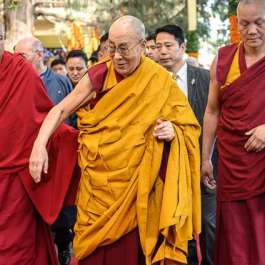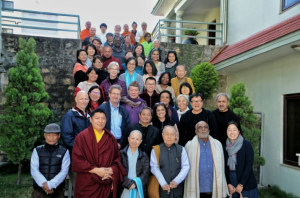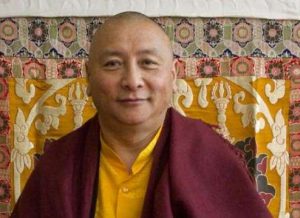In Chi Zhijian’s (遲子建) The Last Quarter of the Moon (额尔古纳河右岸), it is not inter-tribal conflict or the natural elements of snow and storm that destroy the reindeer-herding Evenki (鄂温克族). It is the relentless march of modernism. Modernism is an existential alliance of technology and ideology that liberates us from the old world while enslaving us to the new. Capitalism, collectivization, tree logging, and urbanization force most of the Evenks to abandon their forest “lifeworld” (lebenswelt), the self-evident universe that the community experiences together. Without this shared world of inheritance and memory, the Evenki tribe physically and spiritually dies. As the last Evenks leave for Han Chinese cities, their stories of reindeer, firelight by eventide, and dancing shamans fade away.
Chi is not naïve enough to suggest that the Evenks’ lives were perfect. Violence, anger, jealousy, and superstition are universal conditions, even for tribal people. Nevertheless, her atmospheric and poignant tale offers an important moral that is relevant to all minorities in China: lifeworlds are critical to a people’s survival. They demand respect and preservation.
Mrs. Lee Mei-yin, Special Researcher for Dunhuang Academy, can empathize with the loss of lifeworlds better than most. This is because she has enjoyed extensive contact with Chinese minorities since the 1990’s. She began travelling to meet them after becoming fascinated by their cultures in 1985. Two years have passed since her last trip in the spring of 2012, leading to her exhibit at Hong Kong University’s University Museum and Art Gallery –Embroidered Identities: Ornately Decorated Textiles and Accessories of Chinese Ethnic Minorities (1). After I toured the exhibit, she spoke avidly to me on many occasions about the vanishing virtues of China’s minorities, which share many common values with Buddhism. Mrs. Lee argues that these minorities possess unique value systems that could enrich our urbanized lives and that Buddhists have a rare chance to be informed and inspired by their lifeworlds.
The animism common to 8% of China’s non-Han population does not imply technological or cultural backwardness. When Russian ethnographer Anna Sirina lived with the Katanga Evenks (a different Evenki community from the reindeer herders in China), she coined the term “ecological ethic” for hunter-gatherer societies. She defined this ethic as “a system of responsibility of people to nature and her spirit masters, and of nature to people” (2). This sense of responsibility is inspired by the animist belief in “the embodiment, animation, and personification of nature”. Mrs. Lee has a simple term for this profound sense of humility: gratitude (gan en xin 感恩心). As Sirina observed, even hunters expressed appreciation to their quarry. Their reverent prayers after the chase were directed to the dead animals, begging their spirits for forgiveness. In a lifeworld where killing sentient life is unavoidable, moderation and repentance become central to spirituality and survival.
The “necessity” China’s minorities have for killing becomes a spiritual exercise. This basic sense of guilt and confession provides the foundation of all authentic spirituality, including Buddhism. At the heart of this gratitude is the awareness that the universe is alive with a pulsing, breathing higher power. For a Buddhist, gratitude is akin to faith, and faith in the Buddha is life itself.
The practices of China’s ethnic minorities enact the deepest natural instincts of humankind. Their appreciation for beauty is far removed from the artificial obsessions suffered by modern beauticians and designers. It is informed by instinctive preferences and naturally complementary pairings. Mrs. Lee put it best: “How could the Miao people (miao zu 苗族), with
their tender affection and reverence for spiders, have produced fine textiles so complex, difficult, and perfect that they intentionally mis-wove at least one pattern to express their modesty?” she asks rhetorically. Their baby carriers are absolute masterpieces, unavailable anywhere else in the world. Yet they have no manual, no methodology, and no Miao counterpart to Michelangelo or Manet for emulation.
Mrs. Lee suggests that they have no formal rules, only preferences of color and taste. The Miao people’s artistic impulses flourished because there were no conventions or guidelines, as city-dwellers understand them. In the rural villages, people remain effortlessly natural and humble even though hygiene remains more precarious, work more laborious, and life a bit harder.




For many of China’s minorities, the afterlife and our ancestors are only one shaman dance away. In Buddhism, this world is just an inverted equivalent to the Pure Land. In both Chinese and Western cultures, you insult someone if you call him or her an animal, like a monkey or dog. But this derogatory discourse is a symptom of the disconnect between industrialized societies and nature. The undiscriminating authenticity (zhen 真), kindness (shan 善), and natural beauty (mei 美) of the tribes embody the native values that are so congruent with Buddhism’s ideals of dharma (another word for truth), compassion, and appreciation. While the minorities Mrs. Lee met might not be formal Buddhists, she understands all too well the values that stir their hearts and passions.
The greatest tragedy of China’s minorities is the widespread loss of the ecological ethics that sustained the environment. There is hope in the work of Mrs. Lee and others, who have given so much to tell their stories. But with every attempt at preservation, there remain the haunting reflections of scholars and journalists who had the honor of sharing in the lives of hunter-gatherers. What will the lifeworlds of these minorities look like in a few decades or centuries, when their livelihoods and spirituality are slowly abandoned?
“These people had accepted me instantly and treated me as one of their own. This attitude was not one I had necessarily earned… Today, I miss that openness. I have still not gotten over the fact they have passed away. In a way, a part of me went along with them. The caches, lodge poles, and smudges still stand abandoned in the taiga. Is it possible that the land misses them, in the same manner as people do? Does it remember its former masters?” (3)
Footnotes
(1) The exhibit was held at Hong Kong’s University Museum and Art Gallery from 15th of December 2013 to 9th of February 2014. An accompanying book was released under the same title: Lee, Mei-yin, Knothe, Florian et. al. Embroidered Identities: Ornately Decorated Textiles and Accessories of Chinese Ethnic Minorities. Hong Kong: University Museum and Art Gallery, The University of Hong Kong, 2013.
(2) Sirina, Anna A. People Who Feel the Land: The Ecological Ethic of the Evenki and Eveny. Trans. James E. Walker. Anthropology & Archaeology of Eurasia 3rd ser. 47. Winter 2008 – 9 (2009). 9 – 37.
(3) Sirina, Anna A. Katanga Evenkis in the 20th Century and the Ordering of their Life-world. An authorized translation by A. Chaptyakova from the 2nd Russian edition. Edmonton: Canadian Circumpolar Institute Press, Northern Hunter-Gatherers Research Series, Vol. 2, 2006. 11.












